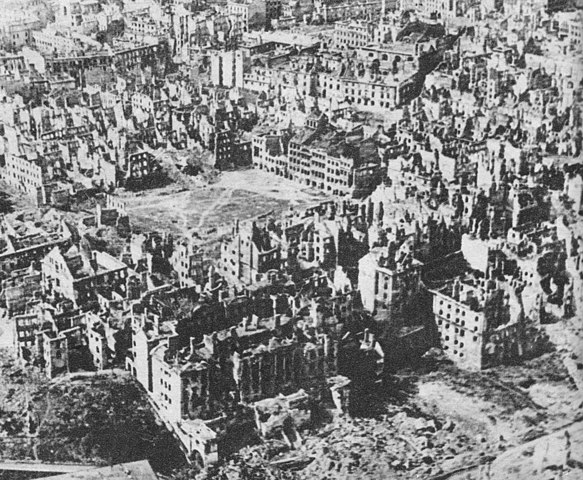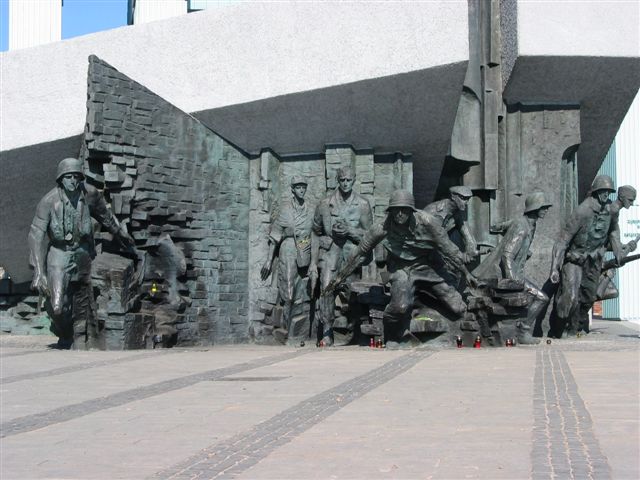
Public Domain (Wikipedia)
On 2 October 1944 the Warsaw Uprising came to an end with the surrender of surviving Polish rebels to German forces. The uprising began two months earlier when the Red Army was approaching Warsaw. The rebels supported the Polish government-in-exile and hoped to gain control of the city before the Soviets arrived. They did not want the Russians to gain the city and establish a communist regime in Poland.
While the rebels had initial gains, they were poorly supplied. Hitler sent reinforcements and the rebels and German soldiers engaged in brutal street fights. The Red Army did take a suburb of Warsaw but proceeded no further. Stalin ordered the Red Army not to assist the rebels and denied a request to use their airbases to supply the rebels. This would be remembered down the road by the Polish people. Both Churchill and Roosevelt asked for his assistance. Churchill, without Soviet approval, had supplies dropped by the RAF, the South African Air Force, and the Polish Air Force. Stalin finally relented and gave air clearance for the U.S. Army Air Force to make supply drops. However, it was too late by the time the supplies came.
Out of arms, supplies and food, there was no choice. After 63 days, they had no choice but to surrender. In retaliation for this uprising, the remaining population of Warsaw was deported. The Polish people were always meant to be eradicated as were the Jews. Plans had been drawn up before the war to turn Poland into a German colony. Warsaw was to be Germanized. Once the remaining population was deported, German destruction of Warsaw was sped up. They had started after the earlier Warsaw Ghetto Uprising. Using flamethrowers and explosives, special teams went to work destroying whole neighborhoods, historical monuments, archives, and any place of interest.
By January 1945, 85% of the buildings in Warsaw were gone. Approximately 25% was done during the Warsaw Uprising. The losses are staggering to consider:
10,455 buildings
923 historical buildings (94% of these were destroyed)
25 churches
14 libraries which includes the National Library
81 schools
64 high schools
The University of Warsaw and Warsaw University of Technology
Of course, prior to these all-Jewish homes, businesses, and synagogues were seized, looted and destroyed as well.
Aftermath
The Soviets took the position that the rebels did not coordinate their plans with them. Of course, the chief reason they did not aid them is that they supported the democratic Polish government-in-exile in London. And Stalin was not interested in supporting them. His goal had been before the war to allow the west to fight themselves to exhaustion allowing for the Soviet Union to expand in their direction. Those that led the uprising and members of the Home Army were persecuted by the Soviets after the war. They were arrested, tried, and deported to Soviet gulags. They had a show trial, not unlike ones during the Great Purge, where confessions were introduced to show they were actually in league with the Germans!
Fortunately, those captured by the Germans and freed by American-British forces were spared this. Stalin and his propaganda machine twisted the facts to show the failings of the Home Army and the Polish government-in-exile. All criticism of the Red Army and Soviet Union by Polish people were forbidden. All references to the Home Army were censored, all books and movies on the Warsaw Uprising were either banned or edited out the Home Army. When that did not work, they made the Home Army soldiers into heroes that were betrayed by their corrupt officers. This would remain in effect until the 1980’s with the rise of Solidarity that challenged the Soviet backed regime. It was not until 1989 that a monument was built in Poland.

Source: Dhirad 2004
In the West, stories of the heroism of the Home Army were told. They were valiant heroes fighting against the Germans. The Soviets were criticized for their non-involvement and that it helped them get rid of partisans that would have opposed them. Despite all the official censorship that existed, many Poles knew what happened and led to growing anti-Soviet sentiment that manifested into the Polish labor movement Solidarity. This peaceful movement in the 1980’s would effect change in Poland and later, as the days of the Soviet Union waned, Poland would gain back the freedom it had lost in 1939.
Sources:
———. “Warsaw Uprising | Summary, Dates, & Monument.” Encyclopedia Britannica. Last modified September 28, 2024. https://www.britannica.com/event/Warsaw-Uprising.
Missy Sullivan, “Warsaw Uprising Ends,” HISTORY, October 1, 2024, http://www.history.com/this-day-in-history/warsaw-uprising-ends.
“The Warsaw Polish Uprising.” https://encyclopedia.ushmm.org/content/en/article/the-warsaw-polish-uprising.
Lester P. Gideon. “The Warsaw Uprising of 1944.” https://www.gideon1.net/uprising/.
“Chronicles of Terror.” https://www.chroniclesofterror.pl/dlibra/results?action=AdvancedSearchAction&type=-3&search_attid1=69&search_value1=Warsaw+Uprising.
Suggested Reading
Bialoszewski, Miron, A Memoir of the Warsaw Uprising (New York Review of Books, 2015).
Davies, Norman. Rising ’44: The Battle for Warsaw. Penguin Books, 2005.
Richie, Alexandra. Warsaw 1944: Hitler, Himmler, and the Warsaw Uprising. Picador, 2019.
Titanic News Channel is a participant in the Amazon Services LLC Associates Program, an affiliate advertising program designed to provide a means for sites to earn advertising fees by advertising and linking to Amazon.com.
[This was updated for 2024 correcting for grammar, punctuation, and revising source information and details.]
